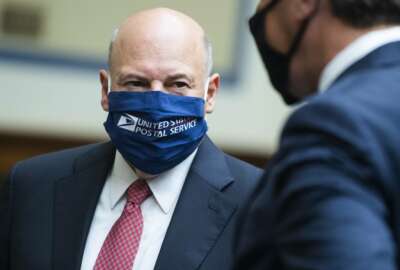

Hubbard Radio Washington DC, LLC. All rights reserved. This website is not intended for users located within the European Economic Area.
Everyone in charge of how the Postal Service operates agrees the agency can’t keep running the way it has been for the past decade. But few can agree on what ...
Everyone in charge of how the Postal Service operates agrees the agency can’t keep running the way it has been for the past decade. But few can agree on what the solution looks like.
While nearly every group invested in postal operations — USPS management, its inspector general, unions, Congress and associations — agree on what the underlying problems are, few can agree on a long-term plan to fix these problems.
The status quo, meanwhile, would lead the agency to run out of cash eventually. USPS has about $25 billion cash on hand, according to recent Treasury Department data, but Postmaster General Louis DeJoy said in a recent interview that the agency could run out of cash by the end of 2022.
A compromise to fix what’s ailing USPS, however, could come into focus with new leadership entering the picture. More than a month after USPS released its 10-year plan to shift its operating model onto a more sustainable path, the Homeland Security and Governmental Affairs Committee will hear from President Joe Biden’s three nominees to serve on the USPS Board of Governors on Thursday.
The nominees are former Deputy Postmaster General Ron Stroman, Anton Hajjar, the former general counsel for the American Postal Workers Union and Amber Reynolds, an election administration expert and CEO of the National Vote at Home Institute.
These nominees, if confirmed, would play a significant role in getting the 10-year reform plan off the ground and would shape how USPS improves its unsustainable business model. The board can also elect to name a new postmaster general or deputy postmaster general.
DeJoy, in an interview earlier this month, said he would welcome having a full Board of Governors for the first time since 2010.
“The full board should have been constituted a long time ago. There was a time when there were no members on the board, which is really kind of hard to believe,” DeJoy said in the April 5 interview.
That period occurred during the Obama administration when the Senate didn’t move forward with any of the White House’s nominees to the board. The board lost its quorum in 2014, and only gained enough presidentially appointed governors to regain a quorum in 2019.
While USPS has already released its 10-year plan, DeJoy said he would welcome input from new governors. He said the plan, however, focuses on issues and solutions with a broad base of support —and doubted the plan would face opposition.
“Who’s against Medicare integration? Not too many people, right? Who’s against the pricing authority that’s been established by our regulators? Not too many people. Who’s against reducing employee turnover in the pre-career ranks? Not too many people. Who’s against growing the business and repointing the organization towards the package business … not to provide profitability — this is a break-even plan — but to cover our costs to continue to deliver mail? I don’t think too many people would be against that,” DeJoy said.
DeJoy added: “If anybody is against any of those, I’m happy to listen. We have a process — there will be nine board members, and they could vote against any one of those things — but it doesn’t seem logical to me that people would want to get in the way of this plan if they’re truly interested in trying to steer the organization in the right direction.”
The head of the Postal Regulatory Commission, the agency that oversees USPS rates and service standards, agrees the Postal Service is best served by a full board.
Michael Kubayanda, the new PRC chairman, speaking last Sunday at the National Postal Supervisors’ Legislative Training Seminar, said USPS has had a tougher time with its operations by not having a full board of governors.
“That’s obviously not optimal in terms of coming up with postal policy decisions,” Kubayanda said.
As for the future of USPS operations, Kubayanda said the PRC is still gathering information about the agency’s level of service during the COVID-19 pandemic, but early forecasts indicate that some of the past year’s surge in packages and e-commerce is likely to stick around even after the pandemic.
“We’ve known for some time that the potential market for e-commerce is very large, in the trillions of dollars, and it appears what happened is a lot of that growth that we were expecting to happen over, say, the last decade has happened over just a period of months in the past year,” Kubayanda said. “Rather than seeing that volume go away, it seems like there’s a chance we’ll stay at this elevated level in terms of e-commerce packages. So I think that presents some opportunities in terms of revenues, and also challenges in terms of operations.”
While its competitive package business looks promising, the future of its monopoly mail business has been murky for years, and has suffered under the pandemic.
Kubayanda said the pandemic has accelerated a decline in “mail density” in the postal network, or the number of mail pieces going to each address or delivery point.
In 2006, 1,400 pieces of mail on average went to every household. Last year, that dropped to 800 per household.
“That’s a huge difference, obviously, and has a huge impact on the economics of postal network,” Kubayanda said, adding that the PRC took mail density into account during its 10-year review of postal rates.
“That is maybe the largest and most important project in the history of the 50-year history of the commission. I’m very proud we were able to produce that regulation late last year,” he said.
The PRC has given the Postal Service authority to raise mail rates, and expects to exercise that authority. As part of its 10-year plan, USPS is also seeking an advisory opinion from the PRC to relax the window for on-time delivery for about 30% of first-class mail.
In terms of performance, USPS faces longstanding challenges with on-time delivery of its mail products, which has only gotten worse under the pandemic.
Last year, as part of the PRC’s annual compliance determination and financial analysis, Kubayanda said USPS only met delivery standards for five of 22 of its market-dominant mail products.
“Obviously it was a strange and unusual year, and our findings reflect what an unusual year it was,” Kubayanda said.
The PRC is in the middle of its annual financial analysis of USPS and is reviewing the agency’s performance plan. Both of these documents, he said, will come out in about a month.
Even in these trying times, Kubayanda said USPS stepped up to deliver essential goods to households during pandemic lockdowns, and kept small businesses afloat when they had to shutter their stores.
“During this time, meeting these opportunities and challenges, I think the Postal Service played a valuable role in helping to bind the nation together. That’s the longtime mission of the Postal Service, but it came to the forefront last year,” Kubayanda said. “We saw businesses have to close down, in terms of their physical locations, and for a lot of small businesses, the only way they could stay open and reach their businesses and reach their customers was through remote means and the Postal Service stepped up to meet that need.”
House and Senate Democrats, however, have pushed back on the 10-year plan, and have called to President Joe Biden to fire the entire Board of Governors in response to significant mail and package delays that happened during the peak holiday season last year.
Chairman of the House Oversight and Reform Subcommittee on Government Operations Gerry Connolly (D-Va.) led more than 50 of his colleagues last month in calling on the president to fire the entire board.
Speaking at the NAPS conference, Connolly said the 10-year plan, which would increase postal rates and downgrade service standards in some instances, would exacerbate the Postal Service’s problems and send the agency “into its final death spiral.”
“That’s where we’re going to fight, because I believe honestly that’s just a model designed to fail. It’s going to hurt the Postal Service and it’s going to cost its customers. When the reliability becomes permanent — that is to say, the lack of reliability becomes permanent, in terms of how many days it’ll take to get delivered —I think you’re going to see customers use alternative means of delivery. And that means our revenue goes down,” Connolly said.
Connolly has led a number of bipartisan postal reform bills in recent years, focused on addressing the USPS mandate to pre-fund retiree health benefits and integrating future postal retirees into Medicare — both provisions that USPS management endorses in its 10-year plan.
Connolly introduced some of that legislation with former Rep. Mark Meadows (R-N.C.) as a cosponsor. However, he said the chance of reaching bipartisan consensus in Congress on this issue isn’t as high as it has been in previous years.
“I’m a lot less hopeful about achieving bipartisan consensus than I would have been if you asked me that question a few years ago, but we’re not going to give up trying,” Connolly said.
Connolly said USPS should also look at expanding opportunities for the Postal Service to make revenue. USPS supports this idea in its 10-year plan, and has proposed expanding its “government storefront concept” to include more biometric and passport services.
Some members of Congress have proposed letting USPS get into the banking business, and offer financial services beyond the money orders already available at most post offices. Connolly said he supports the idea of letting USPS explore other sources of revenue.
“Why put the Postal Service in a straightjacket, if there are ways of raising revenue and even profit … Let’s give broad latitude to the Postal Service to experiment, to pilot in terms of other moneymaking opportunities. Why do we have to do that? Because the traditional business model that relied on first-class mail as its primary moneymaker is gone. First-class mail has collapsed. It doesn’t mean it’s entirely going to go away, but to rely on it as our primary revenue source is obviously not going to happen moving forward,” Connolly said.
Copyright © 2024 Federal News Network. All rights reserved. This website is not intended for users located within the European Economic Area.
Jory Heckman is a reporter at Federal News Network covering U.S. Postal Service, IRS, big data and technology issues.
Follow @jheckmanWFED



